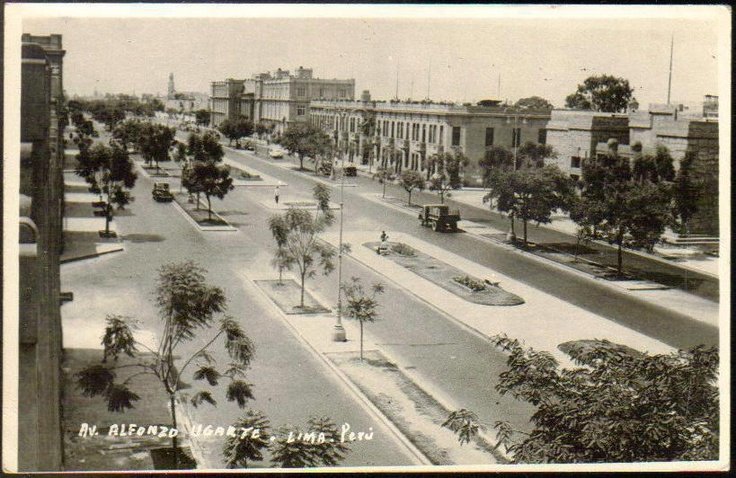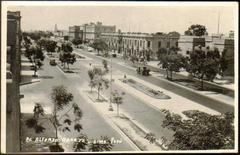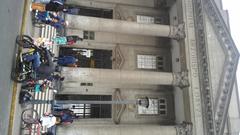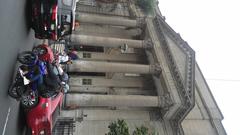
Hospital Nacional Arzobispo Loayza: Visiting Hours, Tickets, and Visitor Information in Lima, Peru
Date: 14/06/2025
Introduction
Hospital Nacional “Arzobispo Loayza” stands as one of Lima’s most prominent healthcare and historical institutions. Founded in the mid-16th century by Jerónimo de Loayza, the first Archbishop of Lima, its original mission was to provide medical care to indigenous populations who had long been excluded from such services. Over centuries, the hospital has evolved into a modern medical center while preserving its profound historical significance, serving as a symbol of social inclusion and public health advancement in Peru (gob.pe).
Today, Hospital Nacional Arzobispo Loayza is recognized for both its ongoing contributions to healthcare and its architectural heritage. The facility features striking neoclassical and colonial influences, with expansive layouts, elegant facades, and serene courtyards that reflect early 20th-century design ideals focused on patient welfare (deperu.com). Visitors can experience select historical areas, including the chapel and courtyards, and gain unique insights into Lima’s urban, social, and medical history (Arquitectura Republicana de Lima).
This guide provides detailed information on the hospital’s visiting hours, ticketing, accessibility, travel tips, and highlights to help you plan a meaningful and respectful visit (mapcarta.com).
Table of Contents
- Introduction
- Historical Background and Foundation
- Architectural Significance
- Cultural and Social Impact
- Visiting Information
- Notable Events & Figures
- Preservation and Visitor Experience
- Frequently Asked Questions (FAQ)
- Summary and Travel Tips
- References
Historical Background and Foundation
The story of Hospital Nacional Arzobispo Loayza dates back to the Hospital de Santa Ana de los Naturales, established in 1549 by Archbishop Jerónimo de Loayza. This institution was groundbreaking for its dedication to indigenous healthcare, serving as a model of compassion and inclusion (gob.pe).
With Lima’s rapid growth, the original hospital became insufficient. The early 20th century saw the construction of a new hospital, authorized in 1905, with the foundational stone laid in 1915. After overcoming financial challenges, the hospital was inaugurated in 1924, on the centenary of the Battle of Ayacucho, and dedicated to its visionary founder (deperu.com). The transfer of staff and patients from the old Santa Ana hospital to the new site ensured continuity of its mission.
Architectural Significance
Occupying nearly 59,000 square meters, the hospital is an excellent example of early 20th-century institutional architecture. Its design prioritizes natural light, ventilation, and green spaces, promoting both hygiene and well-being. Key features include:
- Pavilions and Courtyards: Interconnected pavilions and spacious courtyards create a tranquil environment for recovery and reflection.
- Neoclassical Facades: Symmetrical designs, grand arched windows, and ornate detailing showcase the architectural ambitions of the era.
- Chapel and Religious Iconography: Reflecting its ecclesiastical roots, the hospital includes a chapel and other spiritual elements (gob.pe).
Periodic expansions have blended modern medical facilities with the preservation of historical elements, making the hospital both functional and culturally significant (Arquitectura Republicana de Lima).
Cultural and Social Impact
Social Inclusion
The hospital’s founding principle was the compassionate care of marginalized groups, particularly indigenous Peruvians. This ethos persisted through the centuries and was strengthened by the work of the Sisters of Charity, who administered the hospital for many years (gob.pe).
Education and Research
Hospital Nacional Arzobispo Loayza is a major hub for medical education and research, affiliated with several universities and regularly training new generations of healthcare professionals (gob.pe).
Heritage and Memory
The hospital’s corridors are steeped in history, housing stories of medical innovation and social change. Legends, such as the “headless nurse,” are part of the local folklore, adding to its mystique (relatoscortos.org).
National Importance
Its inauguration on a key date in Peruvian history reinforces its symbolic link to national identity and independence (gob.pe).
Visiting Information
Visiting Hours
-
General Visiting:
- Monday to Friday: 8:00 AM – 6:00 PM
- Saturday: 8:00 AM – 1:00 PM
- Sunday & Public Holidays: Closed
- Note: Hours may vary by department or due to health protocols.
-
Historic Areas (Monument Zone):
- Monday to Friday: 9:00 AM – 4:00 PM
- Saturday & Sunday: Closed
Tickets & Admission
- Admission to public and historic areas is free of charge.
- Guided tours for groups or educational visits must be arranged in advance.
Accessibility
- The hospital is accessible for visitors with disabilities, with ramps and elevators available.
- For specific needs, check with the main entrance or contact administration in advance.
Getting There
- Address: Av. Alfonso Ugarte 848, Breña, Lima, Peru
- Accessible by public transportation (buses along Av. Alfonso Ugarte), taxis, or ride-sharing services.
- Parking is limited; public transport is recommended.
- Located near cultural sites like Museo Nacional de la Cultura Peruana and Plaza Dos de Mayo (mapcarta.com).
Photography & Guided Tours
- Photography is permitted in exterior and designated public spaces; prohibited in clinical areas.
- Guided tours are available on request, especially for cultural or educational groups. Contact the hospital’s cultural department ahead of time.
Notable Events & Figures
Named after Jerónimo de Loayza, the hospital honors his legacy as the founder of Lima’s first hospital for indigenous people. Throughout its modern history, it has been pivotal in combating epidemics and responding to national emergencies, and remains a leader in medical education and public health (gob.pe).
Preservation and Visitor Experience
Conservation Efforts
The hospital is recognized within Lima’s inventory of monumental heritage. Restoration and maintenance focus on preserving original architectural elements, while balancing the needs of a functioning hospital (Arquitectura Republicana de Lima).
Visitor Etiquette
As an active medical facility, visitors should:
- Respect all posted guidelines and restricted areas.
- Maintain a quiet, respectful demeanor.
- Avoid disrupting staff or patients.
- Observe all photography restrictions.
Frequently Asked Questions (FAQ)
Q: What are the current visiting hours?
A: Monday–Friday, 8:00 AM–6:00 PM; Saturday, 8:00 AM–1:00 PM. Historic areas open Monday–Friday, 9:00 AM–4:00 PM.
Q: Is there an admission fee?
A: No, visiting public and historic areas is free.
Q: Are guided tours available?
A: Yes, by appointment. Contact the cultural department or administration.
Q: Is the hospital accessible for people with disabilities?
A: Yes, with ramps and elevators in main areas.
Q: Can I take photographs?
A: Yes, in public and exterior areas; not inside clinical zones.
Summary and Travel Tips
Hospital Nacional Arzobispo Loayza exemplifies Peru’s dedication to inclusive healthcare and the preservation of cultural heritage. Visitors are encouraged to explore its neoclassical architecture, tranquil courtyards, and historic chapel. Free access to public areas, central location, and proximity to other cultural landmarks make it a rewarding stop for history enthusiasts and tourists alike.
For the best experience:
- Verify current visiting hours before your visit.
- Arrange guided tours in advance if interested in a deeper exploration.
- Use public transport due to limited parking.
- Respect all hospital guidelines to maintain a peaceful environment for patients and staff (mapcarta.com).
Stay informed about special events and visitor updates through the hospital’s official channels, and consider using the Audiala app for guided tours and cultural content.
References and Further Reading
- Arquitectura Republicana de Lima
- gob.pe
- deperu.com
- mapcarta.com
- Enfermerix Blog on Hospital History
- PubMed Study on Health Literacy
- relatoscortos.org

















































































































